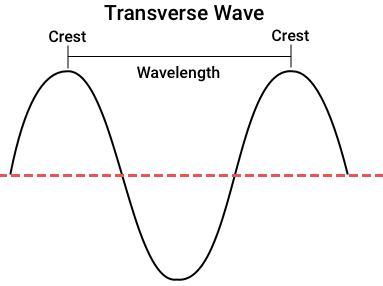
Explain about Transverse Waves?
Answer
493.2k+ views
Hint: Waves can be described as disturbances that propagate from one spot to another through a medium. Waves can be found in a variety of shapes and sizes. While all waves have the same standard qualities and behavior, some waves can be separated from others by specific observable characteristics. One method of classification is based on the direction of movement of individual particles in the medium about the direction of wave propagation. On this basis, waves are classified into two types: transverse waves and longitudinal waves. A transverse wave is one in which the particles move perpendicular to the wave's propagation direction.
Complete answer:
Transverse Waves:
A transverse wave is a moving wave whose oscillations are perpendicular to the wave's direction. By securing one end of the thread and moving the other up and down, a rudimentary demonstration of the wave can be constructed on a horizontal length of a string. Light is another example of a transverse wave, with oscillations that are at right angles to the ideal light rays that describe the propagation route.
Transverse waves are prevalent in elastic solids, and oscillations are the displacement of solid particles from their relaxed state in the direction perpendicular to the wave's propagation. Because these displacements correlate to local shear deformation of the material, transverse waves of this type are referred to as shear waves. Shear waves are sometimes known as secondary waves or S-waves in seismology.

Note: The vibrations of transverse waves are perpendicular to the direction of wave travel.
Examples of transverse waves:
Ripples on the water surface,
vibrations in a guitar string,
Mexican wave at a sports stadium.
Examples of electromagnetic waves include light waves, microwaves, and radio waves.
S-waves in the seismic field.
Complete answer:
Transverse Waves:
A transverse wave is a moving wave whose oscillations are perpendicular to the wave's direction. By securing one end of the thread and moving the other up and down, a rudimentary demonstration of the wave can be constructed on a horizontal length of a string. Light is another example of a transverse wave, with oscillations that are at right angles to the ideal light rays that describe the propagation route.
Transverse waves are prevalent in elastic solids, and oscillations are the displacement of solid particles from their relaxed state in the direction perpendicular to the wave's propagation. Because these displacements correlate to local shear deformation of the material, transverse waves of this type are referred to as shear waves. Shear waves are sometimes known as secondary waves or S-waves in seismology.

Note: The vibrations of transverse waves are perpendicular to the direction of wave travel.
Examples of transverse waves:
Ripples on the water surface,
vibrations in a guitar string,
Mexican wave at a sports stadium.
Examples of electromagnetic waves include light waves, microwaves, and radio waves.
S-waves in the seismic field.
Recently Updated Pages
Why are manures considered better than fertilizers class 11 biology CBSE

Find the coordinates of the midpoint of the line segment class 11 maths CBSE

Distinguish between static friction limiting friction class 11 physics CBSE

The Chairman of the constituent Assembly was A Jawaharlal class 11 social science CBSE

The first National Commission on Labour NCL submitted class 11 social science CBSE

Number of all subshell of n + l 7 is A 4 B 5 C 6 D class 11 chemistry CBSE

Trending doubts
What is meant by exothermic and endothermic reactions class 11 chemistry CBSE

10 examples of friction in our daily life

One Metric ton is equal to kg A 10000 B 1000 C 100 class 11 physics CBSE

1 Quintal is equal to a 110 kg b 10 kg c 100kg d 1000 class 11 physics CBSE

Difference Between Prokaryotic Cells and Eukaryotic Cells

What are Quantum numbers Explain the quantum number class 11 chemistry CBSE




